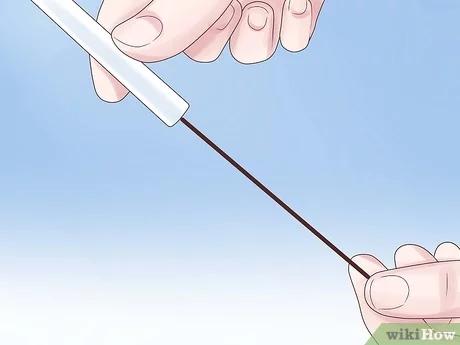5 Ways to Make a Rocket - wikiHow
1. Use the propellant to lift the rocket into and move it through the air. A rocket flies by directing a stream of exhaust downward through one or more nozzles to push it upward (lift) and move it forward (thrust) through the air. Rocket engines work by mixing the actual fuel with a source of oxygen (an oxidizer), which allows them to work in space as well as in Earth’s atmosphere.
The earliest rockets were solid-fuel rockets. These type of rockets include firecrackers, Chinese war rockets, and the two thin booster rockets employed by the Space Shuttle. Most such rockets have a hole in the center for the fuel and oxidizer to meet and combust.[12] The rocket motors used in model rockets use solid-fuel propellants, along with a series of charges to deploy the rocket’s parachute when its fuel is spent.[13]Liquid-fuel rockets feature separate pressurized tanks of a liquid fuel such as gasoline or hydrazine and liquid oxygen. These liquids are pumped into a combustion chamber at the base of the rocket; the exhaust is vented out through a cone-shaped nozzle.[14] The main thrusters on the Space Shuttle were liquid-fuel rockets supported by the external fuel tank carried underneath the shuttle at launch. The Saturn V rockets on the Apollo mission were also liquid-fuel rockets.Many rocket-powered craft also use smaller rockets on their sides to help steer the craft while in space. These are called maneuvering thrusters. The service module attached to the Apollo command module had such thrusters; the Manned Maneuvering Unit backpacks used by Space Shuttle astronauts also used such thrusters.2. Cut air resistance with the nose cone. Air has mass, and the denser it is (particularly near Earth’s surface), the more it holds back objects trying to move through it. Rockets must be streamlined (given elongated, elliptical shapes) to minimize the amount of friction they encounter as they travel through the air, and for this reason, they typically have a pointed nose cone.
Rockets that carry payloads (astronauts, satellites, or explosive warheads) typically carry those loads in or near the nose cones of their rockets. The Apollo command module, for instance, was cone-shaped.The nose cone also carries any guidance system a rocket may be carrying to help direct the rocket to where it’s going without letting it tumble. Guidance systems may include onboard computers, sensors, radar, and radio to provide information and control the rocket’s flight path.[15] (Goddard’s rockets used a gyroscope control system.) .[16]
3. Balance the rocket around its center of mass. The overall weight of the rocket must be balanced around a certain point within the rocket to ensure it flies true without tumbling. The point can be called the balance point, the center of mass, or the center of gravity.
The center of mass for each rocket varies. In general, the balance point will be somewhere above the top of the fuel or pressure chamber.While the payload helps raise the rocket’s center of mass above its pressure chamber, too heavy a payload will make the rocket top-heavy, making it difficult to keep upright before launch and guide during liftoff. For this reason, integrated circuits were incorporated into spacecraft computers to reduce their weight. (This led to the use of similar integrated circuits, or chips, in calculators, digital watches, personal computers, and more recently, computer tablets and smartphones.)4. Stabilize the rocket’s flight with tail fins. Fins help ensure that a rocket’s flight is straight by providing air resistance against changes in direction. Some fins are designed to extend below the rocket nozzle to also keep the rocket standing upright before it is launched.
In the 19th century, Englishman William Hale devised another means for using tail fins to stabilize a rocket’s flight. He devised exhaust ports next to vane-like fins that caused escaping gases to push against the fins and rotate the rocket to keep it from veering. This process is called spin stabilization.[17]-
Latest
 PC/PS4/PS3 CrossPlay Now Available In DC Universe Online ...
PC/PS4/PS3 CrossPlay Now Available In DC Universe Online ...A few weeks ago, Daybreak Games (previously known as Sony Online Entertainment) announced that DC Universe Online would soon feature CrossPlay between PC, PlayStation 4 and PlayStation 3 platforms.Tha...
-
Next
 Cross Play Name Consolidation | DC Universe Online Wiki | Fandom
Cross Play Name Consolidation | DC Universe Online Wiki | FandomCross Play Name Consolidation and FAQ[]Cross play between PC and PS3/4 is planned to launch the week of January 25, 2016. After cross play, players from PC, PS3, and PS4 will all play togeth...
Popular Articles
- Rocket Power (TV Series 1999–2004) - Rocket Power (TV Series ...
- technique - What is the definition of 'playing in the pocket ...
- "Pocket rockets," in poker Crossword Clue Answers, Crossword ...
- 5 Sex Toys Every Man Should Own, Use & Use Again - LA Weekly
- Pocket Holsters: 11 Options For Easy Everyday Carry (2021 ...
- What is Elton John's most successful song? (Celebrity Exclusive)
